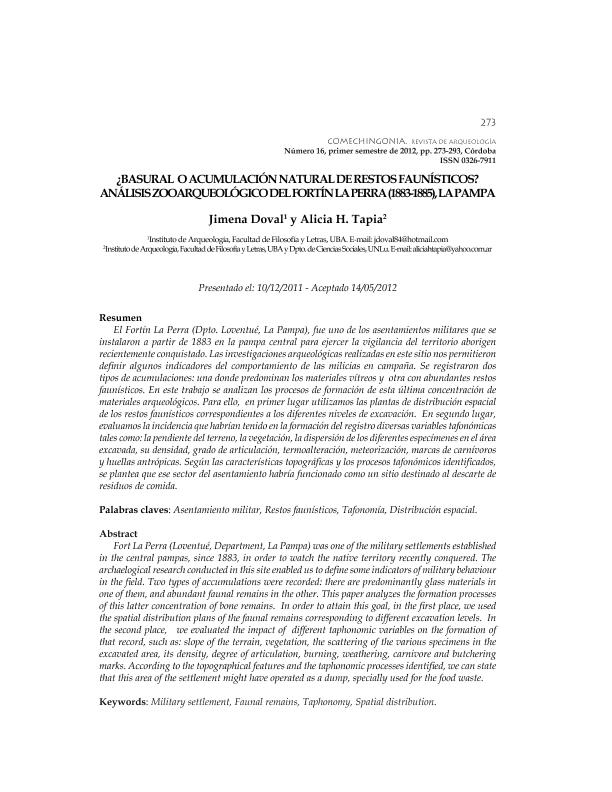Artículo
El Fortín La Perra (Dpto. Loventué, La Pampa), fue uno de los asentamientos militares que seinstalaron a partir de 1883 en la pampa central para ejercer la vigilancia del territorio aborigenrecientemente conquistado. Las investigaciones arqueológicas realizadas en este sitio nos permitieron defi nir algunos indicadores del comportamiento de las milicias en campaña. Se registraron dos tipos de acumulaciones: una donde predominan los materiales vítreos y otra con abundantes restos faunísticos. En este trabajo se analizan los procesos de formación de esta última concentración de materiales arqueológicos. Para ello, en primer lugar utilizamos las plantas de distribución espacial de los restos faunísticos correspondientes a los diferentes niveles de excavación. En segundo lugar, evaluamos la incidencia que habrían tenido en la formación del registro diversas variables tafonómicas tales como: la pendiente del terreno, la vegetación, la dispersión de los diferentes especímenes en el área excavada, su densidad, grado de articulación, termoalteración, meteorización, marcas de carnívoros y huellas antrópicas. Según las características topográfi cas y los procesos tafonómicos identifi cados, se plantea que ese sector del asentamiento habría funcionado como un sitio destinado al descarte de residuos de comida. Fort La Perra (Loventué, Department, La Pampa) was one of the military settlements established in the central pampas, since 1883, in order to watch the native territory recently conquered. The archaelogical research conducted in this site enabled us to defi ne some indicators of military behaviour in the fi eld. Two types of accumulations were recorded: there are predominantly glass materials in one of them, and abundant faunal remains in the other. This paper analyzes the formation processes of this latter concentration of bone remains. In order to attain this goal, in the fi rst place, we used the spatial distribution plans of the faunal remains corresponding to different excavation levels. In the second place, we evaluated the impact of different taphonomic variables on the formation of that record, such as: slope of the terrain, vegetation, the scattering of the various specimens in the excavated area, its density, degree of articulation, burning, weathering, carnivore and butchering marks. According to the topographical features and the taphonomic processes identifi ed, we can state that this area of the settlement might have operated as a dump, specially used for the food waste.
¿Basural o acumulación natural de restos faunísticos?: Análisis zooarqueológico del fortín la perra (1883-1885), La Pampa
Fecha de publicación:
05/2012
Editorial:
Centro de Estudios Históricos "Porf. Carlos S. A. Segreti"
Revista:
Comechingonia
ISSN:
0326-7911
Idioma:
Español
Tipo de recurso:
Artículo publicado
Clasificación temática:
Resumen
Palabras clave:
Asentamiento militar
,
Restos faunísticos
,
tafonomía
,
Distribución espacial
Archivos asociados
Licencia
Identificadores
Colecciones
Articulos(SEDE CENTRAL)
Articulos de SEDE CENTRAL
Articulos de SEDE CENTRAL
Citación
Doval, Jimena; Tapia, Alicia Haydee; ¿Basural o acumulación natural de restos faunísticos?: Análisis zooarqueológico del fortín la perra (1883-1885), La Pampa; Centro de Estudios Históricos "Porf. Carlos S. A. Segreti"; Comechingonia; 16; 2; 5-2012; 273-293
Compartir




